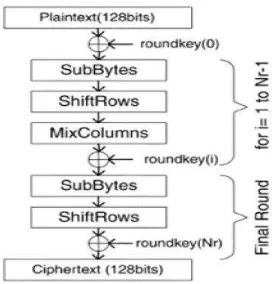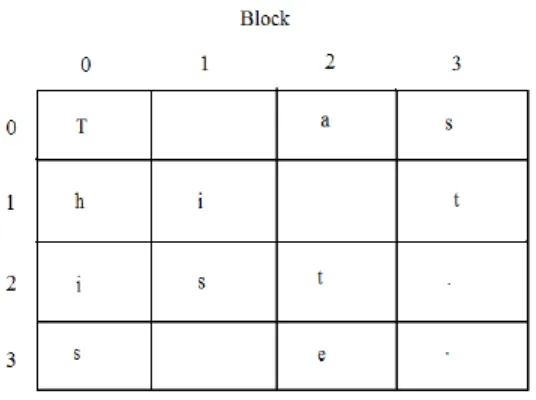1
CHAPTER 1
INTRODUCTION
1.0 Overview
This chapter will cover the introduction of the project where it involve of the project background, problem statement, objective of project, scope of project, thesis outline and summary of work.
1.1 Project Background
2
paper, we report on the implementation and hardware platform of a real time video encryption processing. The processing encrypts videos in real time using the AES Algorithm. We propose a computationally efficient architecture for AES. The system is optimized in terms of execution speed and hardware utilization.
1.2 Project Overview
The project is related to the process of Encryption and Decryption of a plaintext using Advanced Encryption Standards (AES) algorithm, modelled in Xilinx System Generator.
- performing encryption and decryption of text.
- focus on AES algorithm to perform the cryptographic with 256-bit key expansion.
Xilinx System Generator is used in this project because it is easier to use for those who are not very familiar with Hardware Description Language (HDL) such as Verilog and VHDL. By using System Generator approach, it helps those people, also be able to model an AES algorithm.
3
1.3 Objective of Project
Encryption is important to secure data from being accessed by unwanted personnel. The objectives of this project are being able to model an AES encryption algorithm using Xilinx System Generator and to implement them on FPGA.
1.4 Scope of Project
In this project, the main part is to model and implement the Advanced Encryption Standard AES-256 algorithm with Number of Round (��) and apply it on
4
1.5 Thesis Outline
Chapter 1 is about the introduction of the project that consists of project background, problem statement, objectives, scope of project, and summary of work.
Chapter 2 is about the literature review that explains about the background study of the Advanced Encryption Standard and details about Field Programmable Gate Array and mostly about application and the technologies existed before FPGA technology. This literature review also explained about the parameter and technique involved in designing AES algorithm and also stages for each round of AES process.
Chapter 3 explained about the research methodologies that consist of steps of designing AES algorithm and also details about the specifications involved.
Chapter 4 mainly is for the result and analysis of AES algorithm after designing using Xilinx System Generator and Matlab Simulink.
5
CHAPTER 2
LITERATURE REVIEW
2.0 Overview
6
2.1 Previous Projects
2.1.1 Title : FPGA-Based Real-Time Implementation of AES Algorithm for Video Encryption by Sonia Kotel, Medien Zeghid, Adel Baganne, Toufik Saidani, Yousef Ibrahim Daradkeh, and Tourki Rached. [1]
Multimedia data security is becoming an important concern due to the fact that multimedia applications affect many aspects of our life. To deal with the increasing use of multimedia in industrial process, security technologies are being developed. Multimedia encryption algorithms implemented in hardware have emerged as the most viable solution for improving the performance of Multimedia encryption systems. The introduction of reconfigurable devices and high level hardware programming languages has further accelerated the design of encryption technology in FPGA. In this paper, we report on the implementation and hardware platform of a real time video encryption processing. The processing encrypts videos in real time using the AES algorithm. We propose a computationally efficient architecture for AES.
7
Figure 2.1 Full AES Key Storage Memory Address Encoding
For our proposed architecture, a memory elements configured as RAM are used to store the RoundKeys (Figure 2.1). Three RAM’s with 2-bit input address and 128 bit output are used. The three RAM’s as know IPRam1, IPRam2 and IPRam3 blocks are automatically generated by the Xilinx tool. The first AES Round uses the encryption key from the IPRAM1. Then, each turn uses its own key. This arrangement allows simple decoding logic to select the appropriate key for the both AES Round.
2.1.2 Title : Simulation of Image Encryption using AES Algorithm by P.Karthigaikumar and Soumiya Rasheed.[2]
8
Transmission of sensitive data over the communication channel have emphasized the need for fast and secure digital communication networks to achieve the requirements for secrecy, integrity and non-reproduction of exchanged information. Cryptography provides a method for securing and authenticating the transmission of information over insecure channels. It enables us to store sensitive information or transmit it across insecure networks so that unauthorized persons cannot read it. The urgency for secure exchange of digital data resulted in large quantities of different encryption algorithms which are evaluated on the basis of throughput speed of operation and area requirements. There are mainly two types of cryptographic algorithms: symmetric and asymmetric algorithms. Symmetric systems such as Data Encryption Standard (DES), 3DES, and Advanced Encryption Standard (AES) uses an identical key for the sender and receiver; both to encrypt the message text and decrypt the cipher text. Asymmetric systems such as Rivest-Shamir- Adelman (RSA) & Elliptic Curve Cryptosystem (ECC) uses different keys for encryption and decryption. Symmetric cryptosystems is more suitable to encrypt large amount of data with high speed.
9
Figure 2.2 Detailed Block diagram of encryption part
In the encryption of the AES algorithm(Figure 2.2), each round except the final round consists of four transformations:
i. SubBytes: Operates in each byte of the State independently. Each byte
is substituted by corresponding byte in the S-box.
ii. ShiftRow: Cyclically shifts the rows of the State over different offsets. iii. MixColumn: In this operation the column of the State are considered as polynomials over GF(2⁸) and are multiplied with a fixed polynomial. The MixColumn component does not operate in the last round of the algorithm.
10
2.1.3 Title : Advanced Encryption Standard by Douglas Selent.[3]
Advanced Encryption Standard (AES) is the current standard for secret key encryption. AES was created by two Belgian cryptographers, Vincent Rijmen and Joan Daemen, replacing the old Data Encryption Standard (DES). The Federal Information Processing Standard 197 used a standardized version of the algorithm called Rijndael for the Advanced Encryption Standard. The algorithm uses a combination of Exclusive-OR operations (XOR), octet substitution with an S-box, row and column rotations, and a MixColumn. It was successful because it was easy to implement and could run in a reasonable amount of time on a regular computer.
On January 2, 1997 the National Institute of Standards and Technology (NIST) held a contest for a new encryption standard. The previous standard, DES, was no longer adequate for security. It had been the standard since November 23, 1976. Computing power had increased a lot since then and the algorithm was no longer considered safe. In 1998 DES was cracked in less than three days by a specially made computer called the DES cracker. The DES cracker was created by the Electronic Frontier Foundation for less than $ 250,000 and won the RSA DES Challenge II-2. Current alternatives to a new encryption standard were Triple DES (3DES) and International Data Encryption Algorithm (IDEA). The problem was IDEA and 3DES were too slow and IDEA was not free to implement due to patents. NIST wanted a free and easy to implement algorithm that would provide good security.
11
encryption. This standard was called Advanced Encryption Standard and is currently still the standard for encryption.
Figure 2.3 AES-128 block example
Each character is stored in a cell of the block. The blank cells shown in the diagram are not really blank as they represent the spaces in the text. Depending on how the algorithm is implemented the characters may be stored as integer values, hexadecimal values, or even binary strings. All three ways represent the same data. Most diagrams show the hexadecimal values, however integer and string manipulation is much easier to do when actually programming AES. Figure 1 shows the values as characters for demonstration purposes to show how the text is stored into the block. The plain text is stored into blocks column by column and block by block until all the data is stored.

